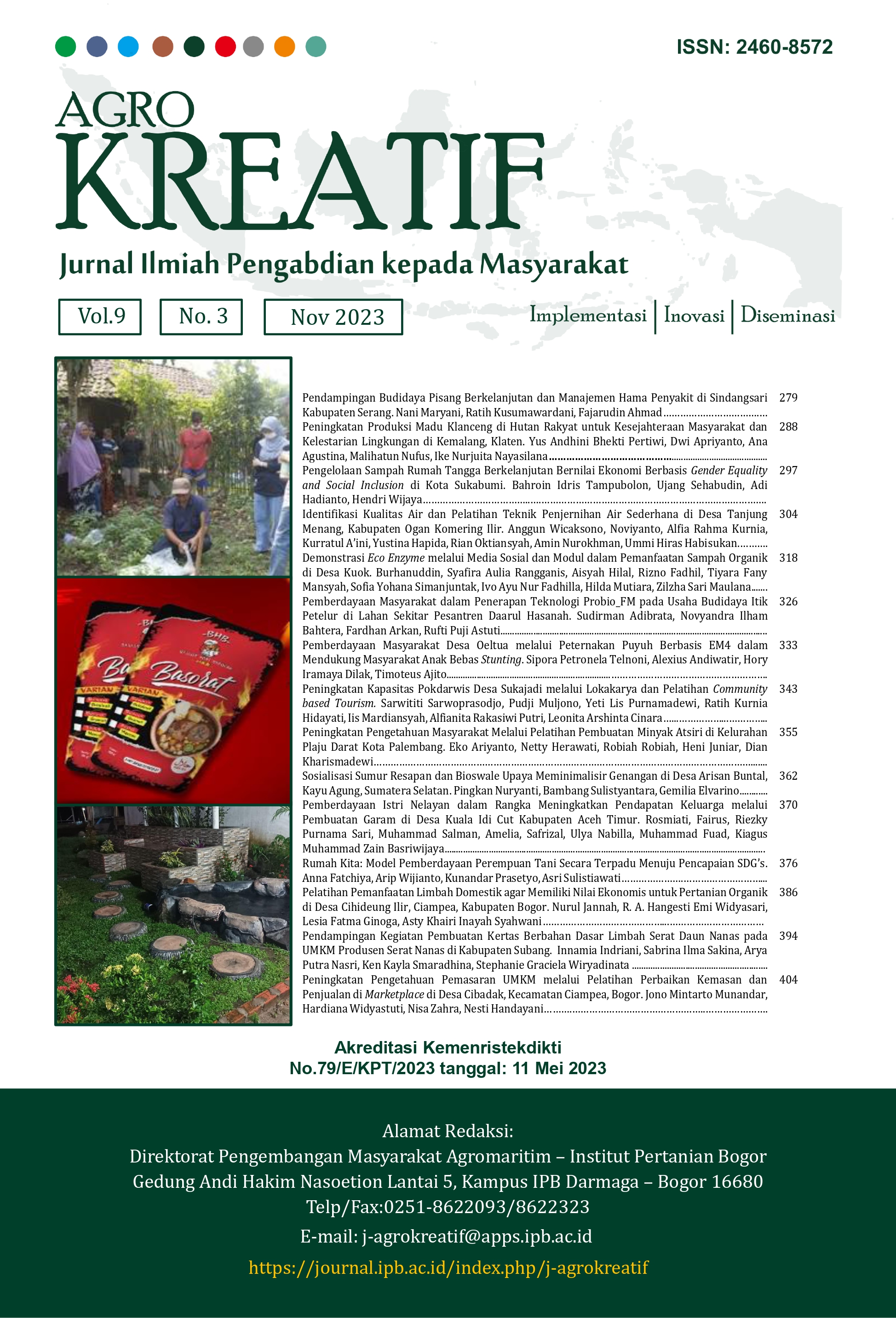Pemberdayaan Masyarakat Desa Oeltua melalui Peternakan Puyuh Berbasis EM4 dalam Mendukung Masyarakat Anak Bebas Stunting
Abstract
Stunting is a child health problem caused by a child's failure to grow according to the child'sgrowthstandards. Stunting can be prevented by consuming animal protein such as eggs and meat. Animal protein contains essential amino acids needed for children's growth. Oeltua Village, Kupang, has a low per capita income value, which has an impact on the community's nutritional intake being unbalanced and resulting in children having the potential to be stunted and stunted. Quail farming can provide people's animal food needs in eggs and meat. EM4-based quail farming can provide food sources of animal protein quantity and quality. PAR method was used in the empowerment; PAR method involves education and data collection on stunting, practice, assistance in raising quail using EM4, monitoring and evaluating quail production. The empowerment socialization was attended by 92% of mothers with toddlers, 5% of fathers accompanying mothers, and 3% of productive women. The health conditions were seven male and 14 female toddlers with the potential to be stunded; 4 male and three female toddlers were stunted. Quail egg production showed increased production in monitoring I‒VIII (27‒224). Egg production is 2‒5 days/house, and the average is 75‒135 months/house to fulfil children's protein needs. EM4-based quail farming can be implemented in the Oeltua Village community. Toddlers need a nutritional intake of animal protein, which can be fulfilled by consuming quail eggs to reduce the potential and incidence of stunting.
Downloads
References
Adesogan AT, Havelaar AH, McKune SL, Eilittä M, Dahl GE. 2019. Animal source foods: Sustainability problem or malnutrition and sustainability solution? Perspective matters. Global Food Security. 25: 1‒7. https://doi.org/10.1016/j.gfs.2019.100325
Arthur J, Bejaei M. 2017. Quail Eggs. Egg Innovations and Strategies for Improvements. Elsevier Inc. Academics Press. https://doi.org/10.1016/B978-0-12-800879-9.00002-0
[BPS] Badan Pusat Statistik Provinsi Nusa Tenggara Timur. [Internet]. [diunduh 2022 Februari 11]. Tersedia pada: https://ntt.bps.go.id/
[BPS] Badan Pusat Statistik Kabupaten Kupang. [Internet]. [diunduh 2022 Februari 11]. Tersedia pada: https://kupangkab.bps.go.id/
El-Deep MM. 2011. Effect of using effective microorganisms as an alternative antibiotics in local domestic fowls nutrition [dissertation]. Kafr El-Sheikh (EGY): Kafr El-Sheikh University.
Lamy E, Harten S Van, Baptista ES, Guerra MMM, Almeida de AM. 2012. Factors Influencing Livestock Productivity. In: Seijan V, Naqvi S, Ezeji T, Lakritz J, Lal R. (eds) Environmental Stress Stress and Amelioration in Livestock Production. Springer Link. https://doi.org/10.1007/978-3-642-29205-7_2
Manvielle F. 2004. The future of Japanese quail for research and production. World’s Poultry Science Journal. 6(4): 500‒507. https://doi.org/10.1079/WPS200433
Nanda S, Mallik BK, Panda PK, Nayak I, Samal SK, Das M. 2015. Effect of Season on Mortality of Japanese Quail (Coturnix Coturnix Japonica) in Different Age Groups. Int Res J Biological Sci. 4(7): 29‒33.
Nkurunziza S, Meessen B, Van geertruyden J-P, Korachais C. 2014.Determinants of stunting and severe stunting among Burundian children aged 6‒23 months: Evidence from a national cross-sectional household survey. BMC Pediatrics. 17(1): 176. https://doi.org/10.1186/s12887-017-0929-2
Parke RS, Leidy MS, Schofield TJ, Miller MA, Morris KL. 2008. Encyclopedia of Infant and Early Childhood Development. Academic Press.
Parents and Caregivers are Essential to Children’s Healthy Development. 2009. American Psychological Association (APA). [Internet]. [diunduh 2022 Oktober 10]. Tersedia: pada: https://www.apa.org/pi/families/resources/parents-caregivers.
Peraturan Menteri Kesehatan Republik Indonesia Nomor 2 Tahun 2020 tentang Standar Antropometri Anak. [Internet]. [diunduh 2022 Des 29]: 1-78. Tersedia pada: https://peraturan.bpk.go.id/Details/152505/permenkes-no-2-tahun-2020.
[KEMENKES] Kementerian Kesehatan. 2019. Peraturan Menteri Kesehatan Republik Indonesia Nomor 28 Tahun 2019.
Puglisi MJ, Fernandez ML. 2022. The Health Benefits of Egg Protein. Nutrients. PMID. 14 (2904): 1‒14. https://doi.org/10.3390/nu14142904
Raharjo S, Rahayu ES, dan Purnomo HS. 2018. Factors affecting quail egg production under the changing climate at Kulonprogo Regency, Indonesia. International Conference on Climate Change. IOP Conf. Series: Earth and Environmental Science. January 2012. https://doi.org/10.1088/1755-1315/200/1/012012
Sahan Z, Kutay H, Celik L. 2021. Influence of Effective Microorganism Supplementation to the Drinking Water on Performance and Some Blood Parameters of Laying Hens Exposed to A High Ambient Temperature. Brazilian Journal Poultry Science. 23 (1): 1‒6. https://doi.org/10.1590/1806-9061-2020-1351
Xiang Q, Wang C, Zhang H, Lai W, Wei H, and Peng J. 2019. “Effects of different probiotics on laying performance, egg quality, oxidative status, and gut health in laying hens. Animals. MDPI. 9 (12): 1‒10. https://doi.org/10.3390/ani9121110
Copyright (c) 2023 Sipora Petronela Telnoni, Alexius Andiwatir, Hory Iramaya Dilak

This work is licensed under a Creative Commons Attribution-NonCommercial 4.0 International License.
This work is licensed under a Creative Commons Attribution-NonCommercial 4.0 International License.



















